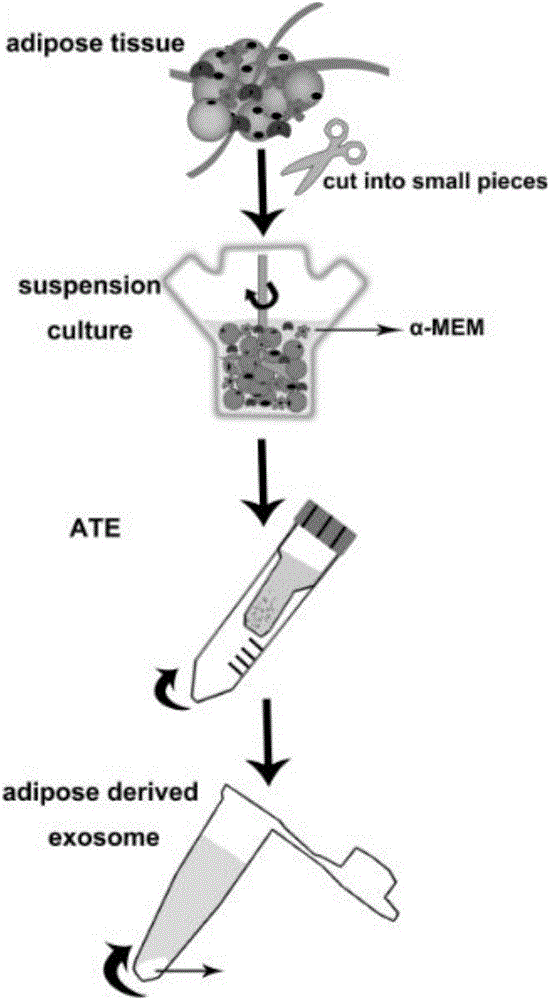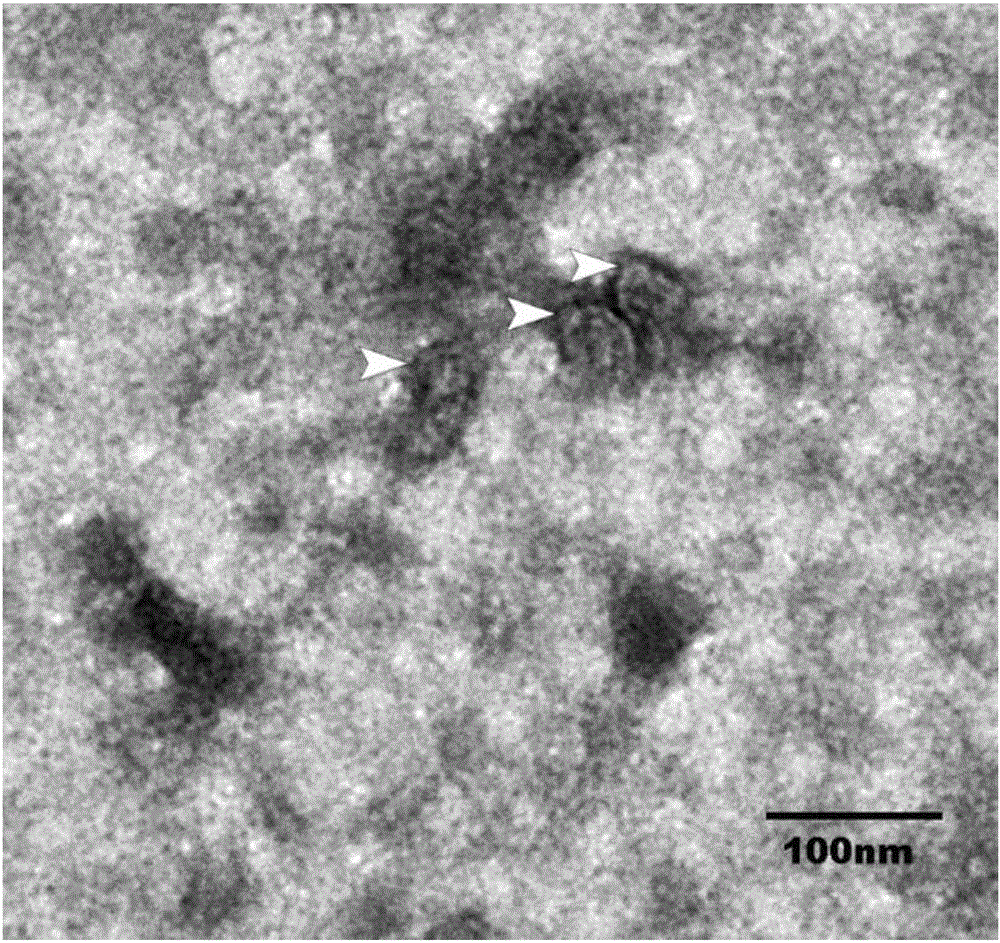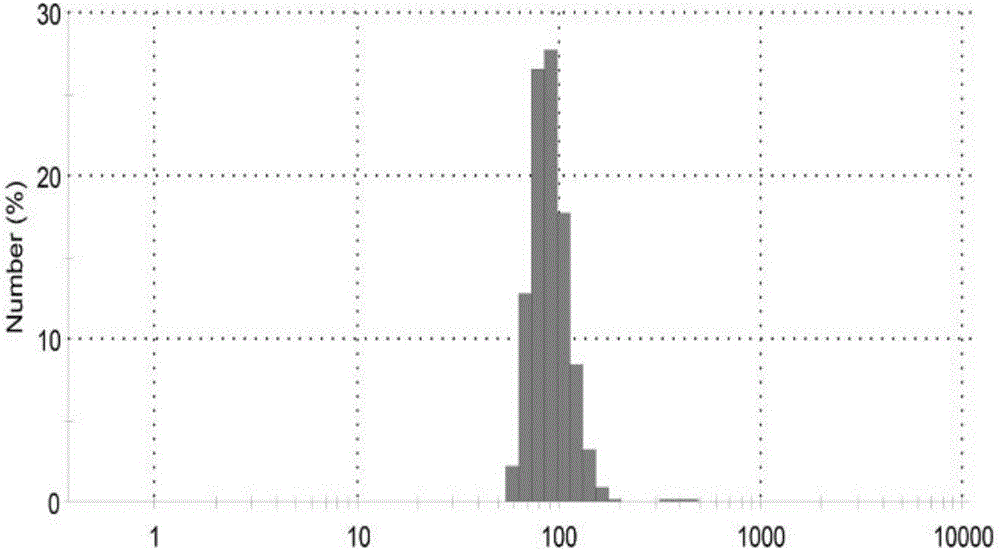Adipose tissue source exosome gel, preparation method and application
A technology of adipose tissue and exosomes, which is applied in the preparation and preparation of exosome glue derived from adipose tissue, and the application in promoting fat regeneration in vivo. In the field of exosomes derived from adipose tissue, it can solve the problems of difficulty, protein and lipid pollution, Safe and harmless, to avoid time-consuming, improve extraction efficiency, and overcome immunogenicity
- Summary
- Abstract
- Description
- Claims
- Application Information
AI Technical Summary
Problems solved by technology
Method used
Image
Examples
example 1
[0046] Example 1 The acquisition of adipose tissue exosomes ( figure 1 )
[0047] Step 1. Processing of adipose tissue
[0048] The bodies of 4-week-old SD rats were sacrificed, sterilized with 75% ethanol Ⅰ for 30 minutes, and 75% ethanol Ⅱ for 30 minutes. Transfer to the aseptic operating table, make an inguinal incision to obtain the bilateral inguinal adipose tissue of SD rats, rinse with sterile PBS, and cut the adipose tissue into small pieces (1-2mm) with tissue scissors. 3 ), it is advisable that the normal extraction of the Pasteur tube can be performed.
[0049] Step 2. Acquisition of Adipose Tissue Extract
[0050] Transfer the shredded adipose tissue obtained in step 1 to a Celstir suspension culture bottle, add serum-free α-MEM medium, the volume ratio of adipose tissue to medium is 1:3.5, keep the speed of suspension culture at 100rpm, store At 37°C, 5% CO 2 Three days later, filter the adipose tissue through a 150-mesh cell sieve to collect the supernatant....
example 2
[0053] Example 2 Identification of adipose tissue-derived exosomes
[0054] Step 1. Morphological Identification by Transmission Electron Microscopy
[0055] Exosomes were fixed with 1% glutaraldehyde, overnight at 4°C. After washing off the fixative, the mixed exosomes were dropped onto the sample-loading copper grid, and then water phosphotungstic acid was added dropwise to negatively stain the exosomes for 1 min. Transmission electron microscopy (Hitachi H-7650) imaging and taking pictures, a circular vesicle-like structure with a diameter of about 100nm can be seen ( Figure 2A ).
[0056] Step 2. Particle size distribution identification
[0057] Take 50 microliters of sample and inject it into a dedicated channel to measure the particle size distribution of exosomes. It can be seen that the peak of the particle size distribution is around 100nm, and the particle size is mainly distributed between 60-150nm ( Figure 2B ). The results proved that the obtained samples w...
example 3
[0058] Example 3 Preparation of matrigel composite adipose tissue-derived exosome implants
[0059] Put the standard Matrigel on ice and thaw overnight in a refrigerator at 4°C. At the same time, pre-cool the required pipette tip and 1ml disposable medical syringe. 200 micrograms of exosome pellet obtained by fresh centrifugation were resuspended in 200 microliters of melted liquid Matrigel (final concentration of exosomes was 1 mg / ml). The obtained liquid matrigel mixed with adipose tissue-derived exosomes was transferred into a pre-cooled 1ml disposable medical syringe, and placed on ice for later use.
[0060] The standard type of matrigel refers to the basic type of matrigel that does not interfere with the proteins and growth factors contained in the matrigel, simulating the structure, composition, physical properties and functions of the cell basement membrane in vivo.
[0061] The volume dilution of Matrigel should not be too high, for example, it should not be greater...
PUM
| Property | Measurement | Unit |
|---|---|---|
| Diameter | aaaaa | aaaaa |
Abstract
Description
Claims
Application Information
 Login to View More
Login to View More - R&D
- Intellectual Property
- Life Sciences
- Materials
- Tech Scout
- Unparalleled Data Quality
- Higher Quality Content
- 60% Fewer Hallucinations
Browse by: Latest US Patents, China's latest patents, Technical Efficacy Thesaurus, Application Domain, Technology Topic, Popular Technical Reports.
© 2025 PatSnap. All rights reserved.Legal|Privacy policy|Modern Slavery Act Transparency Statement|Sitemap|About US| Contact US: help@patsnap.com



